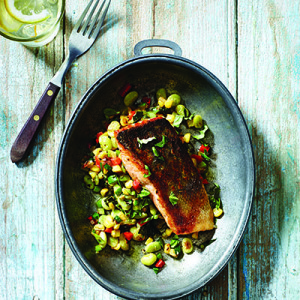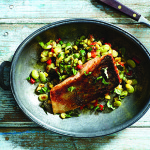
Reprinted with permission from Salmon: Everything You Need to Know + 45 Recipes, by Diane Morgan, ©2016, published by Chronicle Books. Photography ©2016 by Leigh Beisch.
Salmon and succotash are a winning combination of texture, color, and flavor. Variations abound based on the season. In late spring, when fresh wild salmon is in the market, I make succotash with corn, edamame instead of lima beans, asparagus, spring onions, and green garlic. In late summer, I might add cherry tomatoes and definitely use basil in place of parsley. In early fall, I add chanterelle mushrooms and a little fresh thyme. Note my use of Wondra flour, which adds crispness and good color to the skin and is a much better choice than all-purpose flour.
Want More? Read about Diane’s book, get more recipes for salmon, and listen to this recent Food Schmooze® episode to hear Diane share more tips for cooking salmon.
- 4 center-cut salmon fillets (about 6 oz [170 g] each) skin on and scaled, pin bones removed, skin-dried
- fine sea salt
- freshly ground black pepper
- 1/3 cup [40 g] Wondra flour (See recipe note)
- 2 Tbsp. unsalted butter
- 4 Tbsp. [60 ml] extra virgin olive oil
- 1 large shallot chopped
- 1 clove garlic minced
- 1-1/2 cups [190 g] fresh corn kernels
- 2 medium zucchini cut into 1/2-in [12-mm] dice
- 1 medium red bell pepper seeded, deribbed, and cut into 1/2-in [12-mm] dice
- 1/4 cup [7 g] minced fresh basil or flat-leaf parsley
- Remove the salmon from the refrigerator 30 minutes before cooking to bring it to room temperature. Pat dry with paper towels.
- Season both sides of each salmon fillet with salt and pepper. Spread the flour in a pie plate or a wide, shallow bowl. Dip the skin side of each fillet in the flour, shaking off the excess. As the fillets are coated, set them aside, coated-side up, on a plate.
- Place a large frying pan, preferably nonstick, over medium-high heat. When the pan is hot, add 1 Tbsp. each of the butter and olive oil and swirl to coat the bottom of the pan. Add the shallot and garlic and sauté just until fragrant, about 1 minute. Add the corn, zucchini, and bell pepper and sauté, stirring frequently, until crisp-tender and just beginning to brown at the edges, about 5 minutes. Stir in half of the basil and season with salt and pepper. Keep the succotash warm until ready to serve.
- Place a large frying pan, preferably cast iron, over medium-high heat. When the pan is hot, add the remaining 3 Tbsp. olive oil and swirl to coat the bottom of the pan. Add the salmon fillets, skin-side down, then press down on each fillet with the back of a metal spatula to maximize the contact with the surface of the pan. (This helps crisp the skin.) Cook on one side, without disturbing, until the skin is crisp and browned, about 4 min¬utes. Add the remaining 1 Tbsp. butter to the pan and swirl it around the fillets. Turn the fillets skin-side up and cook until the salmon is almost opaque throughout but still very moist, or an instant-read thermometer inserted into the center registers 115° to 120°F [45° to 49°C], about 3 minutes longer.
- Spoon a generous serving of the warm succotash in the center of each warmed dinner plate, place a salmon fillet, skin-side up, on top, and garnish with the remaining basil. Serve immediately.
I learned from a chef friend that Wondra flour, a finely ground instant flour, is a much better choice than all-purpose flour for coating the skin of fish. In a restaurant, when a salmon fillet is served skin-side up and the skin is crackly crisp and beautifully browned, the quality of that texture and coloration comes from the coating—and Wondra flour is the secret. White rice flour is a good gluten-free option.


